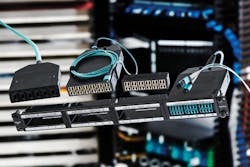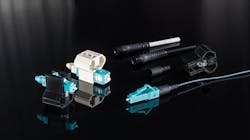Several preterminated solution types are available, each with its own benefits for data connectivity.
By David Rifkin, HellermannTyton North America
Think back to the dawn of network connectivity. Installers set up and deployed networks using cable assemblies fully manufactured onsite. This involved mixing and matching the available components and relying on their wits to select, purchase, receive, measure, cut, terminate, inspect and test (or at least most of those steps) to piece together a one-of-a-kind network link or full connectivity solution.
The process was labor-intensive and inconsistent, relying on each installer understanding their part. They had to follow the proper processes for each step and use appropriate tooling or fixtures to complete and verify theinstallation.
In those days, performance wasn’t the driving force behind a network installation. Low bandwidth and short distances were commonplace, and good enough to work was good enough, period. Standards were used more for reference thancertification.
Now, consider the current state of the art. Today’s networks achieve up to 400-Gbit/sec links instead of 500 MHz, running kilometers instead of meters to connect equipment. Along with the advent of Power over Ethernet and short-wave division multiplexing (SWDM), quality, reliability and consistency become paramount to not only functioning, but also to avoid costly upgrades every time a new technology is implemented.
Direct-connect solutions like HellermannTyton’s RapidNet, shown here, reduce complexity and cost for structured cabling deployments. This article looks at the considerations to make when choosing a preterminated system.
What does preterminated really mean?
Put simply, preterminated refers to commercially available, factory-assembled cabling solutions with the connectors already attached.
However, preterminated solutions come in several flavors. It’s important to know just how much of the solution is truly “open and install.”
Factory-manufactured cable assemblies such as copper pigtails, whips, trunks, permanent links, modular cassettes and fiber patch cords are the ultimate in preterminated options. Reputable cable assembly houses or factories typically employ a wide variety of fixtures, termination and polishing tools, automated machine and state-of-the-art inspection and measuring tools, all of which lead to the ability to manufacture assemblies consistently, reliably, with high efficiency and lower overall costs.
These assemblies usually include inspection and test results, giving the network installer and owner peace of mind. Besides the assumed high quality of workmanship, testing means the assemblies will work the first time.
Eliminating onsite assembly terminations can be a significant benefit. Reduced installation times, troubleshooting and rework mean substantial cost savings over do-it-yourself projects.
Many factory-made solutions will further reduce onsite labor, including patch and trunk, preinstalled enclosures, direct connect trunking and modular-style cassette solutions that provide different levels of both preterminated and preconfigured networking.
Preconfigured direct connect solutions are further able to reduce connection losses by minimizing the number of connection points. Preterminated and fixed cabled cassettes simplify the installation while still providing the granularity needed to be flexible in the deployment.
Planning, however, needs to be taken seriously when using factory-manufactured solutions to ensure the right assemblies are selected with the proper polarity and in the needed lengths—plan twice, order once. A “figure-it-out-as-you-go” approach ultimately will lead to extra costs and delayed installations to order or reorder the more appropriate materials or figure out a way to deal with excessive slack.
Factory-terminated cable assemblies typically include inspection and test results, which provide the network installer and owner peace of mind that the assemblies will work the first time.
Splice-on preterminated fiber pigtails are the next best thing to factory-manufactured solutions. This model uses factory-assembled cable ends made using the same precision fixtures, termination and polishing tools, automated machines and state-of-the-art inspection and measuring tools, but with just a short length of cable.
Pigtails allow bulk or unterminated optical cable to be installed from point to point and can be cut to the exact length needed. An optical fusion splicer permanently connects the bulk fiber cable to the factory-terminated and polished pigtail ends. The greatest benefit to using this method is the installer can have a spool of cable and a stock of factory-terminated pigtails; can run the cable as needed through conduit, trays or walls; cut cable to the exact length and still have the benefit of near-factory manufactured reliability and performance. The downside to this method is that the installer must own or rent a fusion splicer, precision fiber cleaver and the skill set needed to perform, identify and protect a good splice.
Some fusion splicers are extremely basic (even manual), while others feature automation as well as greater speed, costing a couple thousand dollars to more than $50,000. Fusion splices must be protected—within a splice tray or other purpose-designed enclosure—to prevent bending and other stresses from adversely affecting long-term performance. This option may not be practical for the occasional installer but could be beneficial for more active installation companies. This method can cost somewhat more than using fully factory-terminated solutions, but it provides the flexibility to measure or re-measure lengths at the time of cabling to ensure minimal slack and maximum installation flexibility.
Splice-on connectors are a hybrid between pigtails and factory-terminated connectors, providing the flexibility and performance of a splice-on pigtail solution but the convenience of not needing a place to store and protect the splice long-term. The connectors are slightly longer and factory polished like the pigtailed solution, but instead of having the fiber cable exit the connector, the bare fiber is cleaved within the connector body during the factory-termination, creating a fiber stub.
Splice-on connectors do require specialized fusion splicers that stage the connector on one side and provide alignment for the bulk cable on the other. The fusion splice is completed within the connector, typically through specialized ports on the side, creating a reliable fiber connection. As with the pigtail solution, performance can vary based on the quality of the bulk cable cleave and the installation process, but once installed, these assemblies are used the same as a factory-terminated assembly.
Preterminated connectors, also known as prepolished or mechanical splice-type connectors, also permit the use of bulk cables and provide factory-polished endfaces but eliminate the need for the expensive fusion splicers and local electricity. They have a mechanical splice integrated into the back of the connector body with a pre-cleaved and factory-polished fiber stub, allowing the bulk cable fiber to be precision cleaved and inserted. The fiber is accepted through the connector body into an alignment tube or V-groove that aligns the cleaved fiber with the preterminated fiber stub, most using some form of index matching gel to improve the optical light transfer and performance. Removing or activating a mechanical clip or wedge, the fiber is mechanically held into alignment with the internal fiber stub.
This method benefits from the performance of a factory termination and polish, but does have a wider variation in performance due to the varying quality of the cleave and the process of inserting the fiber into the connector. Because the fiber is not epoxied in place, these mechanical solutions tend to have a much wider loss range and are more susceptible to mechanical stresses such as cable pulling, side loading or extreme temperature variation.
This solution is significantly more expensive than the standard field-termination connectors or factory-manufactured assemblies but requires minimal tooling and no polishing, making it fast to install. Care must be taken to select and use the proper fiber type as each connector is assembled with a specific fiber, i.e., multimode needs to be specified as OM1, OM2, or OM3/OM4.
Preterminated fiber pigtails use factory-assembled cable ends that are made using the same precision fixtures, termination and polishing tools, automated machines and state-of-the-art inspection and measuring tools, with a shorter length of cable.
Preconfigured solutions are designed specifically for data networking applications. They are provided with assemblies terminated and, in some cases, factory loaded into enclosures, housings or modular cassettes. Benefits include advanced polarity management (making sure the light travels to the right position within a connector and to the port it is defined for), modular breakouts, fiber aggregation trunking, fiber demarcation and ability to support future upgrades.
Depending on the needs of the deployment, preconfigured solutions can be focused toward lower cost, lower losses, better fiber utilization, changing media, as well as future upgrades and expansion. Modular cassettes can eliminate installation labor and troubleshooting. Direct-connect solutions reduce complexity and loss. Trunk cables reduce congestion. And breakout modules or assemblies allow easy conversion to the equipment interface.
Things to consider when choosing your cabling
Up-front cable run planning is a must when using a preterminated or preconfigured solution. If the wrong fiber, length, connector, performance or fiber count are selected, count on significant additional costs and installation time.
The saying, “Measure twice and cut once,” (or in this case, order once) applies to infrastructure cabling. Too short, and the cable can’t be connected; too long, and slack cable storage becomes a concern.
Also consider material cost versus installed cost. How much labor would be needed along with rework, consumables and troubleshooting compared against a factory-terminated solution? Hidden costs can accumulate over the duration of an installation, reducing profits and extending on-site deployment and certification time.
Preterminated connectors, also known as prepolished or mechanical splice-style connectors, benefit from the performance of a factory termination and polish, but have a wider variation in performance because of varying cleave quality, and the process of inserting the fiber into the connector.
There are many ways to cable your network, from the complete do-it-yourself model to a fully engineered structured cabling solution.
Most options provide the ability to mix and match, accommodating anything from the simple data connection to the most complex systeminstallation.
Networks are evolving from slow, short computer connections to highly sophisticated webs of redundancy. They demand high performance, low losses and long-term reliability, which are no longer easily achieved with the local technician carrying a tool kit, polishing tool and fault locator to the jobsite.
Selecting the proper preterminated and/or preconfigured solution will not only improve the overall performance of the system, but also allow future upgrades while staying within budget.u
David Rifkin is product category manager for datacom at HellermannTyton North America.




